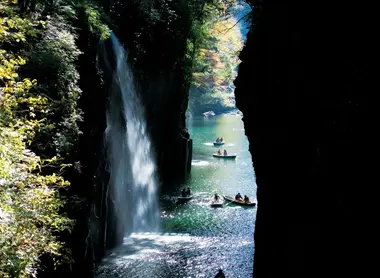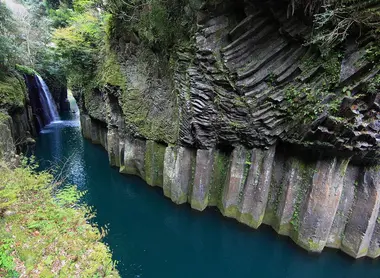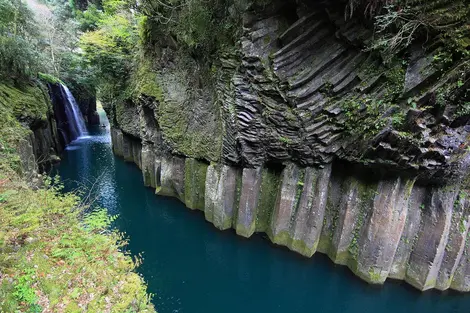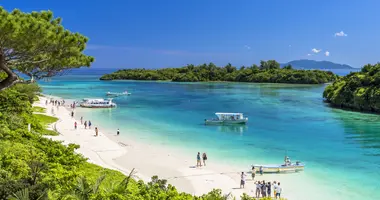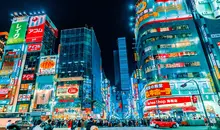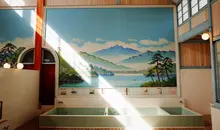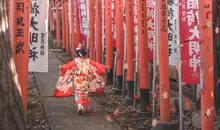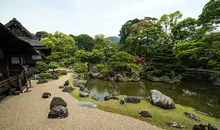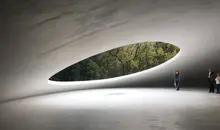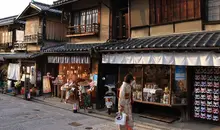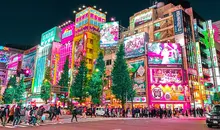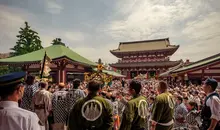Gokase Kumamoto
- Published on : 10/06/2016
- by : G.L.
- Youtube
Volcanic rock
The Gokase River is a major waterway on the island of Kyūshū in Japan, stretching 103 kilometers from its source at Mount Mukōzaka to its mouth in the Hyūga Sea near Nobeoka. Crossing Kumamoto and Miyazaki prefectures, this river is particularly famous for its impressive gorges formed by lava flows from the Aso volcano. Its 1,820 km² river basin is home to remarkable biodiversity and cultural sites of mythological importance. Let's discover together this natural and cultural jewel of Japan, its unique geological features and the many tourist activities it offers visitors.
Geography and characteristics of the Gokase River
The Gokase River (五ヶ瀬川, Gokase-gawa) rises on Mount Mukōzaka, at an altitude of 1,684 meters in Miyazaki prefecture. At 103 kilometers long, it flows through several municipalities including Gokase, Yamato, Takachiho and finally Nobeoka, where it joins the Kita River before emptying into the Hyūga Sea. Its 1,820 km² catchment area covers two prefectures: Miyazaki and Kumamoto.
The river has a variety of geographical features along its course, from the mountainous areas where it rises to the coastal plains it irrigates before reaching the ocean. In some places, notably in the Takachiho region, the river has carved spectacular gorges that attract large numbers of visitors every year. These distinctive rock formations bear witness to the intense volcanic activity that has shaped Kyūshū's landscape over the millennia.
Gokase Gorge: volcanic formations and special features
Gokase Gorge, also known as Takachiho Gorge (高千穂峡, Takachiho-kyō), is one of Japan's most impressive natural landscapes. Classified as a national scenic site and natural monument since 1934, these gorges are the direct result of the volcanic activity of Mount Aso, located east of Kumamoto.
The formation of these gorges is explained by a fascinating geological phenomenon: successive lava flows from Mount Aso, the first of which is thought to date back some 270,000 years, gradually cooled on contact with the Gokase River. This rapid cooling created basaltic formations with astonishing geometric shapes, notably these vertical columns that resemble organ pipes and can reach heights of up to 80-100 metres. These steep walls stretch for some 7 kilometers, creating a V-shaped valley through which the turquoise waters of the river flow.
Continuous water erosion then accentuated the contrasts and further sculpted these formations, giving rise to spectacularly shaped cliffs that sometimes resemble "dragon scales". This unique columnar structure, resulting from the gradual flow and cooling of lava over the years, is an exceptional geological testimony to the region's volcanic history.
Tourist activities and points of interest around the gorge
Gokase Gorge is one of the major tourist attractions in the Takachiho region. They offer visitors several ways to discover their exceptional natural beauty. There are two main ways to explore these geological wonders:
The first option is to take a 1 kilometer hiking trail overlooking the gorge. This relatively flat and accessible trail allows visitors to admire the rock formations from above, offering spectacular panoramic views over the entire landscape. Along the way, there are several vantage points from which to contemplate the river as it winds its way between the sheer walls.
The second, and particularly popular, option is to hire a boat and sail directly down the Gokase River into the heart of the gorge. This unique experience offers a different perspective, where you can observe the imposing basalt columns up close and feel the full majesty of the place. The boat trip costs around 2,000 yen (approx. €15) for 30 minutes and can accommodate up to three people per boat.
A must-see is the 17-metre-high Manai waterfall (Manai no taki), one of Japan's 100 most beautiful waterfalls. This site is particularly popular for admiring the cherry and azalea blossoms in spring, and the glowing leaves in autumn. During the summer, the gorge is illuminated until 10 pm, creating a magical atmosphere and offering a night-time experience much appreciated by visitors.
Other natural sights along the way include Kihachi Rock (Kihachi-no-chikaraishi), a 200-tonne boulder which, according to local legend, was thrown by a deity named Kihachi to demonstrate his power. There's also the 70-metre-high Sennin-no-Byobuiwa cliff, which only hermits with divine strength are said to be able to climb.
Link between Gokase and the Kumamoto region
The Gokase River provides an important natural and cultural link between Kumamoto and Miyazaki prefectures. Although the river has its source in Miyazaki Prefecture, its watershed also extends over part of Kumamoto Prefecture, creating an ecological and geographical connection between these two regions of Kyūshū Island.
The relationship between Gokase and Kumamoto is particularly marked by the influence of Mount Aso, Japan's largest volcano, located in Kumamoto prefecture. This volcano, with its successive eruptions over the millennia, has greatly contributed to shaping the present-day landscape of the Gokase Gorge through its basaltic lava flows. Mount Aso, culminating at 1,592 metres and home to one of the world's largest calderas (25 km by 18 km), is a major geological feature that directly influenced the formation of the gorge.
The Aso and Takachiho regions also share a common cultural and mythological heritage. Both areas are considered important "power spots" in Japanese tradition, places supposedly charged with positive energies where many visitors go to attract good fortune. This spiritual connection further strengthens the links between the Gokase River and Kumamoto Prefecture.
In terms of tourism, visitors often combine exploration of the Gokase Gorge with that of Mount Aso and its surrounding region, creating a natural tourist circuit between the two prefectures. This complementarity of natural attractions promotes regional economic development and trade between Kumamoto and Miyazaki.
How to get to Gokase Gorge from Takachiho
Gokase Gorge is easily accessible from downtown Takachiho, which serves as an ideal starting point for exploring this natural wonder. Here are the main options for getting there:
On foot: If you're staying in the center of Takachiho, the gorge can be reached in around 30 minutes on foot. The route is well signposted and allows you to discover part of the village along the way.
By local bus: A bus service runs from Takachiho Bus Center to the gorge in just 5 minutes. These buses are infrequent, but a convenient option for those who prefer not to walk.
To reach Takachiho itself, travelers have several options:
- From Kumamoto: Direct "Takachiho-go" buses leave from Kumamoto railway or bus station. The journey takes around 3 hours and costs around 2,370 yen from the station (2,160 yen from the airport). Two daily connections are available.
- From Fukuoka: The "Gokase-go" express bus runs from Hakata or Tenjin stations to Takachiho in about 3.5 hours for 4020 yen. There are four connections per day.
- From Miyazaki: A bus connects Miyazaki station to Takachiho in 3 hours for 2,500 yen, with one daily service.
- From Nobeoka: Buses run from Nobeoka to Takachiho in 1.5 hours for 1,790 yen.
For maximum flexibility, we recommend renting a car, especially if you want to explore other sites in the area. The roads leading to Takachiho offer beautiful mountain scenery, especially if you're coming from Kumamoto via Mount Aso. Once in Takachiho, parking is available near the gorge for motorized visitors.
Note that some Takachiho accommodations offer shuttle services to major points of interest, including the gorge, which can be a convenient option for travelers without a vehicle.
Fauna and flora around the Gokase river basin
The Gokase river basin is home to a rich and diverse ecosystem, providing a habitat for numerous plant and animal species. This remarkable biodiversity is fostered by the variety of environments through which the river flows, from mountainous areas to coastal plains.
The vegetation around the Gokase is particularly lush, and varies according to altitude. In the mountainous areas near its source, temperate forests of evergreen and deciduous trees such as Buna (Japanese beech, Fagus crenata) and Mizunara (Japanese oak, Quercus crispula) predominate. At lower altitudes, conifers such as Momi (fir, Abies firma) and Tsuga (Japanese hemlock, Tsuga sieboldii) dominate the landscape.
The banks of the river are lined with cherry trees, which offer an enchanting spectacle during the spring bloom, as well asazaleas and other flowering plants that contribute to the seasonal beauty of the gorge. In autumn, the maples and other deciduous trees turn red, orange and yellow, creating a striking contrast with the black basalt cliffs.
As far as wildlife is concerned, the Gokase River and its surroundings are home to a variety of aquatic and terrestrial species. The river's clear waters are home to several species of freshwater fish that attract local anglers, particularly in June. Amphibians and aquatic insects also contribute to the balance of the river ecosystem.
The surrounding forests are home to a diverse range of birdlife, offering observation opportunities for birdwatchers. The region is also known to be home to a large population of Japanese deer (Cervus nippon), requiring particular vigilance with regard to the ticks that can be found there.
This natural wealth makes the Gokase basin a privileged place for nature lovers, offering varied experiences according to the season and contributing to the region's tourist appeal.
Cultural and mythological significance of the Gokase-Takachiho region
The Gokase-Takachiho region occupies a central place in Japanese mythology and is considered one of the country's spiritual cradles. The area is commonly referred to as the "city where the gods dwell" (kami ga sumau machi) or the "birthplace of mythology" (shinwa no furusato), testifying to its exceptional cultural importance.
According to Japanese legends, Takachiho is the place where the gods descended from Takama-ga-hara (the celestial kingdom) to earth. But the most famous mythological episode associated with this region concerns the sun goddess Amaterasu, central figure of the Shinto pantheon and mythical ancestor of the Japanese imperial family.
According to the Kojiki, one of Japan's oldest historical texts, Amaterasu, deeply offended by her brother Susanoo's chaotic behavior, took refuge in a cave at Takachiho, near the Gokase Gorge. This retreat plunged the world into darkness. To get her out and bring light back to earth, the other deities gathered in theAmano Yasugawara cave, near the gorge. It was here that the goddess Ame-no-Uzume is said to have performed a provocative dance which, triggering the laughter of the other gods, aroused Amaterasu's curiosity and prompted her to come out of hiding.
This legendary divine dance is considered to be the origin of Kagura, a traditional Japanese art form still practiced today. Takachiho Yokagura, a Shinto ritual dance, is regularly performed at the Takachiho-jinja shrine, re-enacting this mythological episode. This cultural tradition, designated as an important intangible cultural asset of Japan, attracts many visitors who attend the nightly performances.
The region is home to several sacred sites linked to these legends, including the Amanoiwato Shrine, built near the supposed Amaterasu Cave, and the 1,800-year-old Takachiho Shrine, which administers 88 other shrines in the area. These places attract not only tourists but also pilgrims in search of a spiritual connection.
This rich mythological dimension, combined with the natural beauty of the Gokase Gorge, makes this region a unique crossroads where nature and culture intertwine, offering visitors an experience that is both aesthetic and spiritual, deeply rooted in Japanese cultural identity.
Address, timetable & access
Address
Timetable
8.30am - 5pm in seasonPrice
Boat rental: 2,000 yen (€15) / 30 min (3 pers. maximum)Access
By bus from Takachiho station (5 min.) or on foot from downtown (30 min.).
